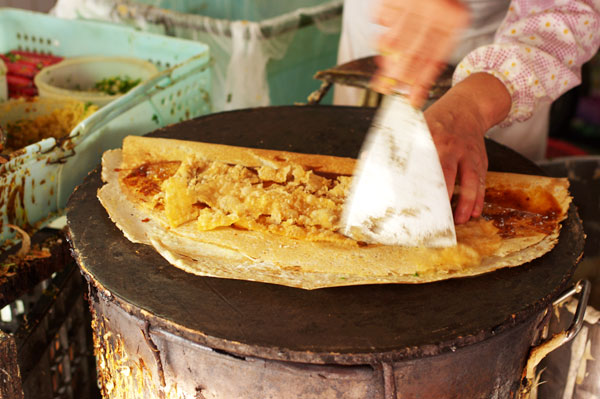Eat your way across Shanghai on foot
 |
|
A Shanghai breakfast stand serves jianbing, or Tianjin-style pancake. Another food store offers pan-fried bun stuffed with pork. Photos by Ray Kuka / China Daily |
 |
|
A Shanghai breakfast stand serves jianbing, or Tianjin-style pancake. Another food store offers pan-fried bun stuffed with pork. Photos by Ray Kuka / China Daily |
He tells us "this place is good" as he smiles with much more energy than I do, but then again my stomach is still empty. That's about to change thanks to his vote of satisfaction and the delights placed before me at a street vendor's spot in Shanghai's former French Concession.
"Everyone in here is just super friendly, super nice and they're always curious because they don't see many foreigners in these small places," says Jamie Barys, my tour guide, who founded UnTour just over two years ago with colleague Kyle Long, both from the United States.
We tried almost everything available at our first stop. A puffy egg crepe or danbing was first - and although oily, it was delicious and surprisingly fluffy.
My favorite at this corner, though, were the so-called "pot-stickers", Shanghainese fried dumplings or guotie. Tour guide Barys had to teach me how to devour them, by first warning me to poke a hole in the side in case the liquid is boiling inside.
"When you eat, you can hear everyone around us is making slurping noises, and they do that to bring the cool air in with the hot liquid so it doesn't scald their tongue. If you slurp loudly, it's easier to eat," she says.
The steaming sauce trapped inside explodes into your mouth with a hit of spice and meat, balanced perfectly with a touch of Shanghainese vinegar on your spoon.
Our inquisitive 90-year-old friend, who tells me in English through laughter that he's an "old Chinese man", prefers the congee for breakfast. Barys dared suggest it's easier for the older folk to eat, and we'd be giving it a miss this time.
As a foreigner new to Shanghai, I'm always unsure what is safe to eat and what isn't. Barys says always look for queues of people - if the Chinese don't go there, you shouldn't either. Also check for a stash of oil in bottles to make sure it's fresh and not illegally recycled.
As we head to our next stop, Barys shares the history of the street stalls and the buildings around us, along with a mingle among the calligraphy artists and morning dancers.
This tour is not just about food, but also about the culture and history of Shanghai.
Passion for food is in Barys' blood - her mother works in a bakery. But her love of Chinese food comes from when she started studying in Beijing. Like it is for many Westerners, the experience wasn't love at first sight.
"Our study abroad group went out for dinner and one of the students, a Chinese-American who grew up speaking Mandarin, thought he would play a practical joke on all of us. He ordered drunken shrimp and bull frog," she says.
"Let's just say I didn't eat much of my first meal. Eating frog, which is really boney, lacking experience with chopsticks, wasn't ideal."
Barys resorted to rice until a friend took her to a dumpling house and the food heavens opened. "I ate about 50 dumplings in my first sitting," she says.
With some confidence, she then tried ordering again, this time successfully.
"It was amazing because it had food from every province, and the menu had English, pinyin and Chinese characters. So I took a menu and basically made it my bible. It was a lifesaver. Two or three weeks into the program when I couldn't still speak Mandarin, I was able to order for everyone at restaurants," she says.
"That's kind of how I came to love Chinese food. When I was initially terrified, the menu was fantastic. I mean I don't know what I would have done without it."
At our next stop: pulled noodles with sesame oil (congyou banmian). The texture and the flavors were simple, but great. We combined the noodles with bamboo tofu and green peppers (qingjiao fuzhu).
A tour of Chinese breakfast foods wouldn't be complete without an order of soup dumplings. Remember to use the special vinegar created at the restaurant, we're advised. It's steeped with ginger and of course, being in Shanghai, has added sugar.
We finish the tour with something sweet, a traditional Macanese egg custard tart, or danta. The Portuguese-inspired buttery pastry is topped with a creamy egg filling that isn't too sweet.
The informative, filling and fun breakfast tour lasts between two and three hours and all stops are within a 2-km radius. It includes a tour of the wet market in case you're brave enough to try Chinese cooking yourself.
Barys and her colleague Long also run noodle, dumpling and running tours through Shanghai. You'll receive an itinerary for all the restaurants you have visited after the tour.
Find out more about the food tours at www.untourshanghai.com.
sundayed@chinadaily.com.cn
(China Daily 03/16/2013 page12)
















